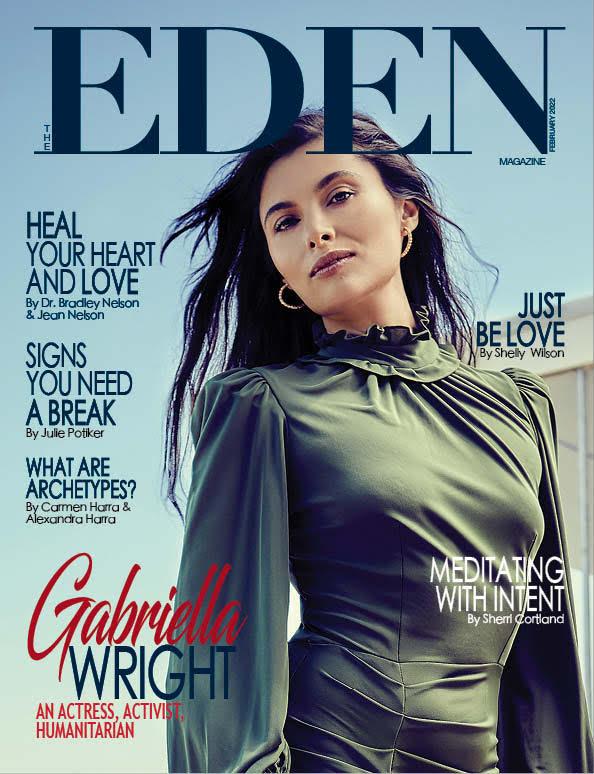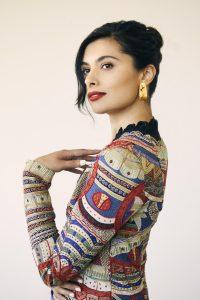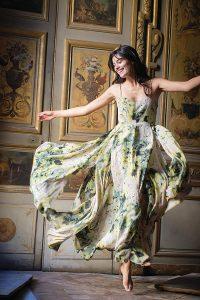
Gabriella Wright
By Dina Morrone
Gabriella Wright, actress, activist, humanitarian, co-founder with Deepak Chopra and Poonacha Machaiah of Never Alone, a suicide prevention initiative, and innovator of Mental Hygiene Toolkit, opens up about her passions, causes, and acting role in the yet to be released film, We Are Never Alone.
Please tell us how your life’s journey brought you from London to California?
It was my U.K. agent in 2010 who asked me to go to Los Angeles to do Pilot Season. That’s how I first got acquainted with my love for California. As time went by, I started working more and more with the U.S., and now most of my projects start in the U.S. before they migrate to the rest of the world.
How did you segue from a graduate in English Literature and Social Economics to a career as an actress?
With my father being an artist, I was surrounded by art. He was one of the first artists to do performance and video art in the 60s. So, art was the common language at home. It was my natural state of being if I could call it as such. It was a stretch for me to study Social
Economics, but I wanted to understand the world and how societies are structured. I was and am still interested in international relations. It would explain, in a way, why art was and is always my number one way of creative expression and with a relationship to the world that is expressed through my inner and outer need to understand human behavior. Shakespeare is one of the most acute observers of human behavior and the entanglement of how human stories bleed through generations over and over again. As actors, we explore the journey of translating these emotions and feelings so the audience can experience a form of catharsis. So, to answer your question, it is all connected. It’s just a continuum of a path.
Of all the acting roles you’ve interpreted, which one has been the most impactful?
I could answer this in so many different ways. We take on acting roles for different reasons. Some are purely financial. Some are because they reflect a state of being, a shadow part of oneself that has yet to be explored. I played a woman who suffered from severe bipolar disorder after losing a child. It was a very challenging role, and I learned so much about the diversity of our inner mental states. Years later, I worked mental health into my roles. They have almost always preempted parts of my life.
Also, I am finally feeling free as a woman to embrace my full self-expression in so many different ways. In my latest role, a film yet to be released, We Are Never Alone, I play a mother who loses her son to suicide. It was a very challenging role – the stages of grief – yet very timely. We experience grief as a collective constantly. So many things we don’t talk about hide under the surface of our being.I still believe the best roles have yet to come!
You also co-founded the Never Alone Suicide Prevention and Mental Well-Being Initiative of The Chopra Foundation. Would you please speak to us about this movement and how our readers can get involved?
I never thought I would be a co-founder of a mental health initiative. At the time, I was focused on releasing trauma for women and girls and victims of violence. A lot of my humanitarian activities until then had been engaged in empowerment programs for various charities in Asia.
But then, three and half years ago, my little sister, a singer-songwriter, died by suicide. There had been signs in the past, but living in a failing system where mental health is not a priority, or it is seen and labeled as a distinct illness, brings a lot of shame to the person experiencing it. As a family, we had been navigating the ups and downs of helplessly witnessing someone with hidden suffering, and we knew no way of how to help her. Her songs are magnificent and speak about the intensity of the razor’s edge, and suddenly she left us. After that, I realized that I could not just sit back and participate in a collective passive societal structure with no bridges and do nothing.
Of course, I had to heal, and so did my family. The intention was set. I met Dr. Deepak Chopra, and we brainstormed with his colleagues on how to help alleviate suffering in general. Every 40 seconds, someone dies by suicide in the world.
We have a lot of programs that are in development. During the pandemic, we released an emotional A.I. chatbot (a chat function) named Piwi, after my little sister. I am thrilled to say six million minutes have been exchanged on the platform, and 13 million text messages exchanged. This service is free, and you can find her on our website. This year, we hope to release a new program called Freedom from Suffering.
Read Our Magazine…
What do you do daily to stay focused and grounded?
Every day I do meditation, self-inquiry, Qi Gong, and sleep at least eight hours. I also research and constantly learn something new about the state of the world. I am constantly immersed in the thought pattern of how we can create a beautiful world for all where joy is at the center of everyone’s daily choice.
Is there something you have been passionate about since you were a child that still pleases you today?
I am completely in awe of nature. David Attenborough is still my childhood hero, and I am still engaged with his compelling storytelling. His love for nature and living entities has never left me. I love the infinite languages the world encompasses. I think in another life, I would have loved being an explorer, like him. To a certain extent, I have explored nature, especially the Himalayas, in the most recent years. That brings me great enjoyment.
Of all your travels, which place has had a lasting impact on you and changed the way you see the world?
India and Nepal. India opened my eyes to the human condition, and the importance of understanding the state of our human suffering and the contrary joy found in the presence of a moment. Nepal, because of the vastness of kindness that I can find on everyone’s face. It’s a gentile soothing feeling, and I also feel the Himalayas are the womb of the world. I feel safe, at peace, timeless.

You have been meditating for over 20 years. What is the difference between meditation and meditation with elements?
Meditation has only one goal, to go to the source of thought, which is entangled with every sensation, feeling, image, and thought.
Meditation is a way to create a deeper relationship with who you truly are. The “I” has no name, no story, no identity. The destination is the journey itself. Meditation is a tool to explore your true nature beyond any concept you could ever imagine.
Meditation for self-realization is liberation from everything and everything that you think that reality is.
The elements such as fire, water, air, earth, and ether can also take you to the source since they are part of reality. Any meditation can take you to the source of all thought, the source of infinite awareness, the birth of reality itself.
There are many different methods, and sometimes one has to explore to find and expand our relationship with pure consciousness as long as you stick with it and create a routine of expanding reality.
Would you please tell us more about your dedication to sharing your meditation practice with parolees in the greater Los Angeles area?
Yes, before the pandemic, I regularly went to Amity Foundation with director Michel Pascal. He is the director of the meditation program there. It’s a lovely experience, and they continue to deliver great work and help the parolees. We even filmed there for our film, We Are Never Alone. A lot of love is simply shared because when we get to the bottom of everything and anything, love is all that is found. And once you find that moment, you feel at home. A lot of the work we have done, and continue to do, is filled with that soul intention of taking each other home to a place of self-love and peace.
What is the best way to heal from grief and guilt?
That is a very long answer. Sometimes you have to sit with things. There is timing, a natural rhythm to everything. One could say a cycle. Sometimes you just have to sit with these turbulent emotions, and when I say sit, you have to sit in the middle of the storm. Like a storm, when you sit in the middle, the storm finally lets go of its center, and finally, the emotions stop twirling, and there you are again. You must observe your body.
See where the tightness of grief lies, where the shame of guilt lies. Write your thoughts down. Do not stay in your head and mind. Create a relationship with yourself, despite how guilty you feel about the story you have engaged with.
I realized over time that grief is a testimony of the love you have for the one who has departed. Accept its presence. Accept the beauty of grief, and as you do, know that you are never alone. Grief is part of the deeper healing and acceptance of impermanence.

What does it mean to you to be a Social Icon?
Simply always focusing on others, listening, learning, and being present to certain suffering in the world and bringing light to it.
As a motivational speaker, you have had the opportunity to speak to so many through the various platforms available. Please share one inspiring story from one of these events that affected you deeply and emotionally, and why?
Yes, there have been so many experiences, and in a way, each one is so precious.
I think what I love the most is when I can sense transformation and breakthroughs, especially with the youth. Young girls and boys need to be heard and listened to. When one speaks, you have to listen to the silence of a room.
One of the most intimidating talks and yet a talk that changed my life and self-confidence was in January 2020. I was invited to speak at Amrita University on campus in Kerala, in south India. This talk was for all of the teachers and higher officials of the university. No students. I was presenting the importance of mental hygiene as a distinction. The room was full of Ph.D.’s and well-regarded professors, and there I was, an actress with, yes, maybe half a life of meditation and self-awareness but by no means any university scholarly mindset. Life had consumed me, and I had not returned to continue my university path even though I wanted to. I was intimidated, yet I felt so much love in the room. I was thinking, what could they possibly learn from me? They know way more than I do.
That’s when I realized the power of storytelling and how to share in a way that breaks open the shell of so many. That was the most extended lecture I had ever given by myself – two and half hours of sharing how to overcome trauma and create safe spaces for one’s mind in any setting. It was interactive and fun. Sometimes their listening was so intense you could almost hear a pin drop. It was joyful, yet everything was based on reality. Many professors came to thank me for bringing light to the plight of mental health in university settings and sharing part of my mission. They felt empowered to play their part for the students as the school year started. Little did we know at that time that this great pandemic was circling our way.
What was the turning point when you realized you had to create change through activism?
When I went to India, notably in the Bihar region of India, I could not accept all the human suffering I witnessed for the first time.
As a Catholic child, I was taught to pray every night. But I realized the so-called “God” did not answer my prayers to help all the world’s starving children. So, I lost faith and stopped believing and praying. Seventeen years later, when I went to India, I saw a group of kids crawling on their hands due to polio deformity and lack of resources. So, I did research and started raising awareness on these “rag pickers.” Rag pickers in India are children who collect rags from the rubbish to make money. They are street kids who live a risky life of peril. After witnessing this, I could not just return home and live. My mind was back with the children, and that’s how it all started.
What is the one thing you cannot live without and why?
I cannot live without my Mala and my prayer beads. My Tibetan teacher gave them to me when I was very sick in the hospital going through a tough time personally. I healed, and ever since, my prayer beads have been with me
to every country, through every hardship and situation. And I can’t live without my tea.
Please share with our readers your upcoming projects.
We Are Never Alone shall be released this year. I am looking forward to sharing it with the world. I also have a new series called Never Alone Artists, where we explore the themes of mental health, the world of music, and much more. But these two projects are the ones coming out soon!
Photographer: ©JSquared Photography (@j2pix)
Styling: David Gangel
Hair: Eduardo Mendez
Makeup: Robert Bryan

Comments